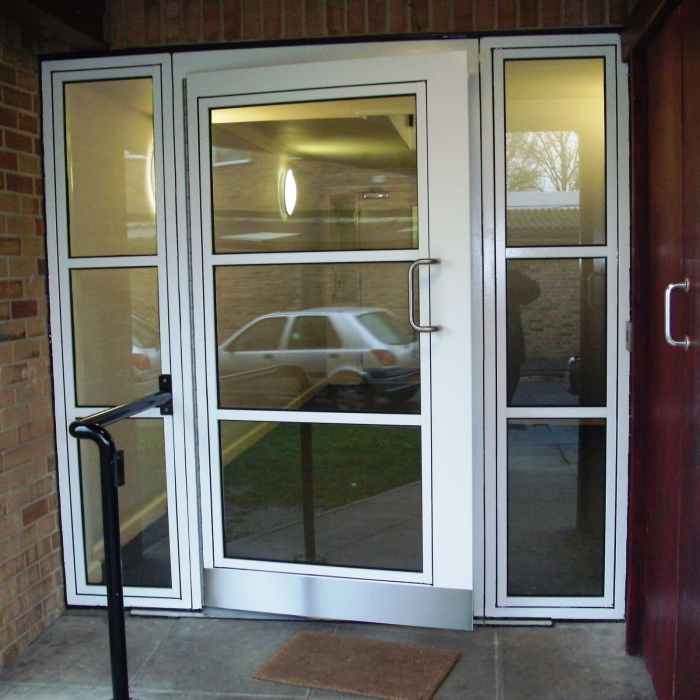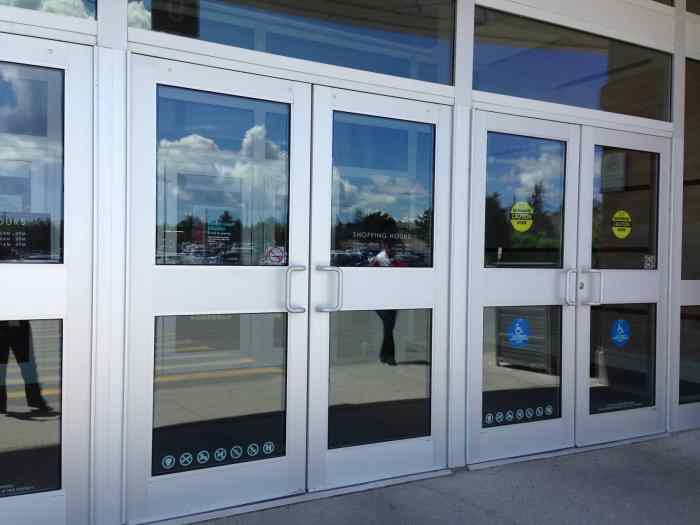Exploring the World of Commercial Entry Doors
Commercial entry doors open up a world of possibilities, from sleek glass doors to sturdy metal options and convenient automatic entrances. Each type offers unique features and benefits, catering to different needs and preferences. Let's delve into the realm of commercial entry doors to uncover the secrets behind their durability, security, and style.
As we navigate through the various types, factors to consider, installation and maintenance tips, and security features, you'll gain a comprehensive understanding of how these doors can transform a space while ensuring safety and functionality.
Types of Commercial Entry Doors
When it comes to commercial entry doors, there are several types to choose from, each with its own set of features and benefits. Let's explore some of the most common options available:
Glass Doors
Glass doors are a popular choice for commercial spaces as they provide a modern and sleek look. They allow natural light to filter through, creating a welcoming atmosphere for customers. Additionally, glass doors are easy to maintain and can be customized with different finishes and designs.
Metal Doors
Metal doors are known for their durability and security features. They are resistant to wear and tear, making them a long-lasting option for high-traffic areas. Metal doors also provide excellent insulation, helping to regulate temperature within the building.
Automatic Doors
Automatic doors are convenient for businesses with a high volume of foot traffic. They open and close automatically, allowing for easy access for customers and employees. These doors are also equipped with safety sensors to prevent accidents and ensure smooth operation.
Comparing Durability and Security
When comparing the durability and security aspects of different types of commercial entry doors, metal doors generally offer the highest level of security due to their sturdy construction. Glass doors, while elegant, may not provide the same level of protection.
Automatic doors, on the other hand, combine convenience with security features to ensure a safe and efficient entry point.
Factors to Consider When Choosing Commercial Entry Doors
When selecting commercial entry doors, several key factors need to be taken into account to ensure the functionality, security, and aesthetics of the building. Here are some crucial considerations to keep in mind:
Material Selection
The choice of material for commercial entry doors is essential as it determines the durability, security, and maintenance requirements of the doors. Common materials used for commercial entry doors include steel, aluminum, and wood.
- Steel doors are known for their strength and security, making them ideal for high-traffic areas.
- Aluminum doors are lightweight and corrosion-resistant, making them suitable for modern designs and areas with high moisture levels.
- Wood doors offer a classic and elegant look, but require more maintenance to keep them in excellent condition.
Design and Aesthetics
The design and aesthetics of commercial entry doors play a significant role in creating a positive first impression on visitors and customers. It is crucial to choose a door design that complements the overall architecture and branding of the building.
Factors such as color, style, and hardware details should be considered to enhance the visual appeal of the entry doors.
Energy Efficiency and Insulation
Energy efficiency and insulation are important considerations when selecting commercial entry doors, especially in buildings where heating and cooling costs are significant. Well-insulated doors can help maintain a comfortable indoor temperature, reduce energy consumption, and lower utility bills. Look for doors with features such as weather-stripping, double or triple glazing, and thermal breaks to improve energy efficiency and insulation.
Installation and Maintenance of Commercial Entry Doors

Installing and maintaining commercial entry doors is crucial for ensuring the security and functionality of a building. Proper installation and regular maintenance can enhance the longevity of the doors and improve overall security measures.
Installation of Commercial Entry Doors
Follow these steps for a successful installation:
- Measure the doorway accurately to ensure the correct size of the door.
- Prepare the door frame by ensuring it is level and plumb.
- Attach the hinges to the door and then to the frame, ensuring they are properly aligned.
- Install the doorknob, lock, and any additional security features.
- Test the door to ensure it opens and closes smoothly and securely.
Maintenance of Commercial Entry Doors
Regular maintenance practices can help prolong the life of commercial entry doors:
- Inspect the door regularly for any signs of wear and tear, such as cracks or dents.
- Keep the door clean by regularly washing it with mild soap and water.
- Check the hinges and locks for any loose screws and tighten them as needed.
- Apply a fresh coat of paint or sealant to protect the door from elements and maintain its appearance.
Proper installation and maintenance of commercial entry doors can significantly enhance the security of a building by ensuring that the doors function properly and are in good condition to prevent unauthorized access.
Security Features in Commercial Entry Doors

Commercial entry doors are equipped with advanced security features to ensure the safety of the premises. These security technologies are essential in protecting against unauthorized access and potential threats.
Biometric Access Control Systems
Access control systems such as biometric scanners are integrated into commercial entry doors to enhance security. Biometric technology allows for secure and efficient access control by verifying an individual's unique biological traits, such as fingerprint or retina scans.
- Biometric access control systems provide a higher level of security compared to traditional key or card-based systems.
- These systems are convenient and user-friendly, allowing authorized personnel easy access while restricting entry to unauthorized individuals.
- Biometric access control systems help prevent security breaches and ensure only authorized personnel can enter the premises.
Compliance with Building Codes
It is crucial for commercial entry doors to comply with building codes related to security standards. Building codes Artikel specific requirements for door hardware, locking mechanisms, and access control systems to ensure maximum security.
Compliance with building codes is essential to meet safety regulations and protect the occupants of the building from potential security risks.
- Commercial entry doors must meet fire safety regulations to provide a safe exit in case of emergencies.
- Building codes may also specify the use of certain security features, such as panic bars or emergency exit devices, to ensure quick and easy egress.
- By adhering to building codes, commercial establishments can create a secure environment for employees, customers, and visitors.
Final Thoughts
In conclusion, commercial entry doors serve as more than just an entrance - they are a statement piece, a security measure, and a practical choice for any business or commercial space. By exploring the intricacies of these doors, we've unveiled the importance of choosing the right type, considering key factors, and maintaining them for long-lasting performance.
Dive into the world of commercial entry doors and elevate your space with style and security.
FAQs
Are automatic doors a good choice for commercial spaces?
Automatic doors are convenient for high-traffic areas, providing ease of access and seamless entry for customers and employees alike. However, they may require more maintenance compared to manual doors.
How important is energy efficiency when selecting commercial entry doors?
Energy efficiency is crucial as it can help reduce heating and cooling costs for a commercial space. Look for doors with good insulation properties to ensure energy savings in the long run.
What security technologies are commonly integrated into commercial entry doors?
Security features like smart locks, access control systems, and surveillance cameras are often integrated into commercial entry doors to enhance safety and protect the premises.